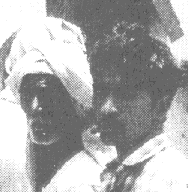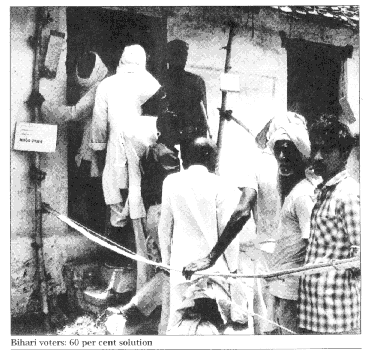People's turn

by
Walter Hauser*


This has provided a rich opportunity to interact with and learn from the people of the cities, towns, and villages who are the central players in these and all elections. As also from the candidates who seek their votes, and from the administrators, the election officials and the returning officers who mobilise this unique exercise in democracy.
In anticipation of the Bihar polls I travelled recently from Ranchi in Chhotanagpur to Patna, Barh, Nalanda and Munger in central Bihar, to Hajipur, Muzaffarpur, Darbhanga, Madhubani and Purnea, north of the Ganga.
As each time before, whether Lok Sabha or assembly elections, the encounter has been revealing. The cliche that it has to be seen to be believed is entirely apt here. A parliamentary election in India is by definition the largest democratic electoral exercise ever to be undertaken, any time, any place. The sheer numbers involved and the logistics of mobilising an open democratic election with an adult franchise approximating 590 million eligible voters are staggering. This is more eligible voters than the population of all but two countries on the planet.
More than 800,000 polling stations will serve this electorate, 200,000 more than were set up for 1991 elections. In Bihar the number of polling stations is up from about 64,000 in 1991 to 82,828 in 1996, the electorate up from 50.45 million to 58.4 million. The national electorate is up 80 million over the 1991 figure. The goal is to have less than 1,000 voters per polling place, and ideally never to go above 1,200 so that HO voter need walk more than two kilometers to his or her polling place.
Equally remarkable as these numbers and what they mean in terms of organising so massive a public event, is the extent of voter participation and what this means as an expression of the will of the people. In Bihar, in the last three general elections, voter turnout has been at or slightly above 60 per cent. In 1977 it reached nearly 61 per cent.
Equally significant and revealing is the consistent increase in voter participation and presumably, therefore, voter awareness. Between 1952 and 1962 the turnout in Bihar went up from 40.5 per cent to 47 per cent. It reached 51.5 per cent in 1967, remaining roughly at that level in 1971. It retained in 1980 and the three most recent elections the level achieved with the upward movement to the 60 per cent mark in 1977.
Also important in these calculations is that there has been relatively little or no fall off in these Lok Sabha figures in voter participation in assembly elections, citing here also the case of Bihar. In the 11 assembly elections between 1952 and 1995, the voter turnout was below 50 per cent only in 1957 and 1962. It reached the 60 per cent level or better in both the 1990 and 1995 elections.
In comparison the United States has seen a significant fall off in voter participation between national, especially presidential, elections and state elections. In any event, voter participation in the US seldom reaches over 50 per cent. State elections often attract voter participation in percentages as low as the forties or thirties.
There is also a difference in the aggressive registration of all eligible voters over 18 in India as compared to the voluntary, and therefore less than total, registration of voters in the US. In the 1992 US presidential elections there were only 133.8 million names on the rolls.
This figure is meant to place the Indian experience of voter participation in the perspective of democratic electoral politics worldwide. By that standard India's voter turnout of between 50 per cent and 60 per cent and above is certainly among the highest, barring those few polities where voting is mandated by law. And those percentages of voter turnout have been more than maintained in the first round of voting in the current Lok Sabha and assembly elections, anxieties about the effect of campaign restrictions imposed by the model code of conduct notwithstanding.

Press reports indicate that violence was "marginal". That in those sensitive areas where problems were most expected, polling was generally peaceful and voter participation good. The latest reports have the Election Commission undertaking repolling in 446 polling booths including all the 129 booths in an Assam assembly constituency where misprinted ballots were used. This means that there is repolling in 317 out of the 203,705 polling stations which voted on April 27, as a result of captured booths, intimidation of voters and polling staff, and so on.
Even assuming wide underreporting of such episodes, the numbers are nevertheless insignificant in the overall. There was prompt identification of these 317 polling places where manipulation occurred, many of the perpetrators were arrested and immediate repolling under heavy security scheduled. All this suggests the EC is exercising its constitutional mandate of implementing a free and fair election within the human limits so massive an undertaking in so complex a social and political environment imposes. In other words, in a significant measure the votes cast in this election, for and against candidates and parties, as in previous elections, do indeed represent the democratic will of the Indian people.
It must be said the EC in its efforts to regulate and reform the system is damned if it does and damned if it doesn't. Previous commissions, though committed to reform, were condemned for their failure to move more expeditiously in these efforts. The current EC, aggressively determined to enforce election laws and the model code of conduct, is criticised for being overzealous, overspending in implementing its watchdog functions. Also, by restricting visual and oral representations in the campaign especially posters, banners, wall paintings, and loud speakers-it is accused of having in effect produced a lacklustre campaign and limited the flow of information to the voters.
The voter turnout in the first phase of voting and my brief initial election foray into Bihar suggests that voters, candidates and returning officers by and large feel differently. We now know the model code of conduct has not diminished voter turnout. And the consensus among candidates and party workers in Bihar to whom I spoke is that the effects of the model code have been salutary.
The close regulation of campaign expenditures, the limits on visual and sound representations, have obliged candidates to move personally far more widely in their constituencies and among the voters. One observer noted there was less vulgar competition in outdoing the next candidate and party in more and better posters and banners. It may all be less colourful and festive but the general sense is that it is less costly and has produced a healthier election environment.
There will be exceptions` and qualifications to these assessments, especially from candidates and parties not likely to win. They will charge that the process, however positive, is still controlled by the party and government in power. In fact, historically, incumbent parties lose elections and therefore power, despite the administration and management of a given election being in their hands.
As an American I will add that if these efforts at limiting campaign expenditures and the model code serve to control the spread of television campaigning and the 30 second sound bite-both of which are major problems in US electoral politics-the EC will by definition have benefitted the Indian electoral process to everyone's advantage.
These observations are not unqualified and uncritical praise of electoral politics in India I know the meaning of poll violence and booth capturing. And having concerned myself with peasant activism as a historical phenomenon, I also understand the many forms of intimidation in rural India and rural Bihar. But all the irregularities notwithstanding, and in the overall they are limited, I maintain that the final result, when all ballots are counted, does represent the will of the people.
In the 1984 parliamentary elections there was a provision that if a candidate got more than 90 per cent of the vote in a given polling booth, that result was suggestive of manipulation and would be included only if the results in the constituency as a whole were affected. Based on boothwise results for one of my sample parliamentary constituencies, I systematically deleted all votes where candidates had received 90 per cent of the votes in a polling booth, and did this for all booths in the constituency.
The results remained the same, that is the winning, second, and third place finishers were identical by virtually the identical percentages as if the full vote had been included. I should add a caveat here that 90 per cent of the votes for a given candidate in any polling booth in India, or precinct in the US, does not inevitably imply rigging. It depends entirely on the nature of the polling site and the voters there.
Indian voters know far more about their social, economic, and political interests than some cynical urban observers give them credit for. The world Bank definitions of literacy and illiteracy are not terms in my explanatory lexicon of life in rural India. Peasants do not need to read an English language newspaper to cast an informed and intelligent ballot. They produced the food and provided the political constituency which achieved freedom in 1947. They play an equally critical role in the political process in 1996. They are the backbone of the dynamic democratic polity that is India in the late 20th century. It is a democratic polity that may be flawed, but I know of none that is not.